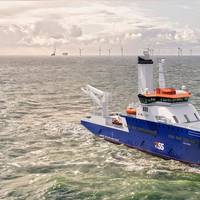Construction of CSOV for Taiwan’s Offshore Wind Market Kicks Off in Vietnam

The steel cutting ceremony for the new Construction Service Operation Vessel (CSOV), being built by Damen for Ta San Shang Marine (TSSM), a joint venture between Japan’s Mitsui O.S.K. Lines and Taiwan’s Ta Tong Marine, took place in Vietnam.The steel cutting ceremony for the CSOV was held on January 19, 2024 in Ha Long, just two months after the initial contract was signed.TSSM’s new CSOV will be named TSS Cruiser and will be delivered by Dutch shipbuilder Damen by late 2025.TSS Cruiser will be chartered to contractors supporting the offshore wind farms near the coast of Taiwan…
DNV GL's Examines the next Decade's Tech Outlook
Every five years, DNV GL publishes a Technology Outlook report providing insights into the technology landscape of the next decade. Its latest report focuses extensively on top tech trends and the future outlook for maritime, oil and gas, energy, and life sciences. The DNV GL Technology Outlook 2025 identifies four dominant catalysts driving technology innovation globally, namely digitalization, climate change, politics and regulation, and sustainable resource consumption. The digitalization of information flows will spur the automation of existing processes and functions, and have a positive impact on safety and environmental performance. Ships today are developing into sophisticated sensor hubs and data generators.
ClassNK, TÜV Rheinland Sign Partnership Agreement
Press release - ClassNK and TÜV Rheinland Group have concluded a worldwide partnership agreement to expand their testing and certification services portfolio and better serve their clients. ClassNK is a nonprofit classification society with experience in certifying materials and equipment for maritime use, while TÜV Rheinland is a product testing and certification body. Both certification bodies operate globally. Advances in technology and economic growth mean that more and more materials and equipment are being designed for both onshore and maritime installations. Manufacturers of this dual-use equipment face lengthy and costly testing and certification processes before their products can be placed on the market.






